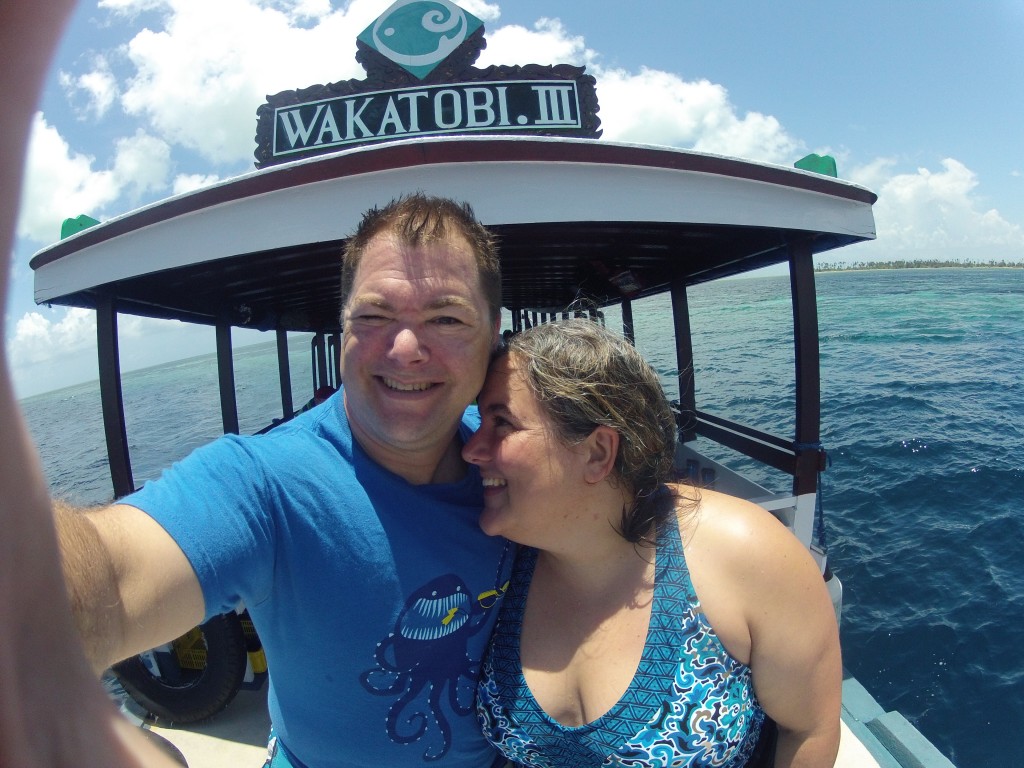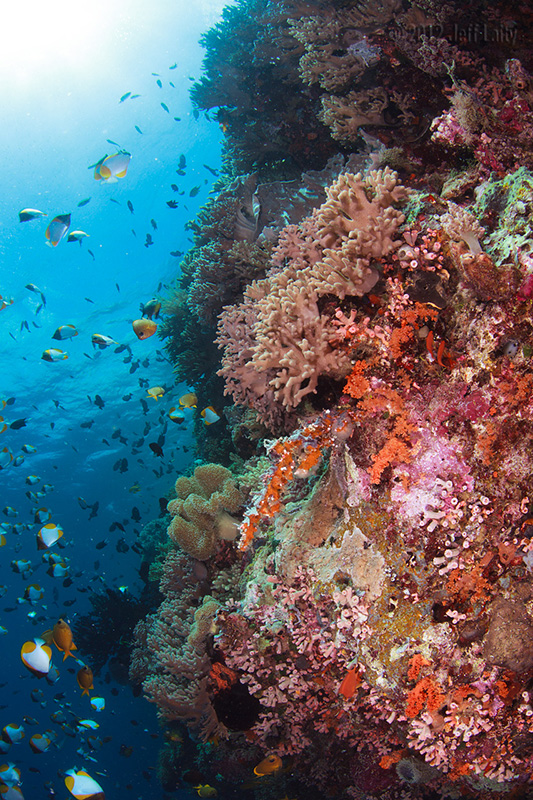Indonesia October 2012 – 5 nights in Paradise
The next few days were basically Diver Heaven! Our Wakatobi routine went like this:
1. Breakfast
2. Dive #1
3. Dive #2
4. Lunch
5. Dive #3
6. Snacks
7. Dusk/Night Dive
8. Dinner
9. Zzzzzzzz
For those of you curious about the specifics of diving of Wakatobi, here’s a little more detail on how they operate:
When you arrive, you’re assigned to one of their dive boats for your stay. They have a board next to the dive center showing the schedule for the duration of your visit, with the planned dive sites for each boat on each day. Next to it is a tide table, which is helpful for planning when you might want to skip the boat and do a shore dive on the house reef instead.
Each diver has a numbered spot on a bench in the dive center, with space to hang gear and a crate underneath for all your miscellaneous stuff. In the morning, porters take your gear to the dive boat for you – unless you’ve indicated on the board that you’re planning to do a shore dive instead.
The boats’ departure times are also listed on the dive center board – usually around 7:30, 9:45 and 2:45.
By the way – these are really roomy, nice dive boats!

Our boat usually had 3 or 4 different groups diving from it, though one group was just snorkelers. They try to match people up with other divers who share the same diving style; we had filled out a detailed questionnaire before arrival about how we liked to dive (slowly and taking lots of pictures, in our case).
The dives are 70 minutes max when you’re with the group on the boat. (If you do a house reef dive, you can dive as long as you like.)
All that hype I’ve heard about the Wakatobi reefs? Not overblown. They were a wide-angle photographer’s paradise!
Most of our dives were drift dives – the boat drops you off, you go along with the current, and the boat picks you up again wherever you wind up. Current can be tricky when you’re trying to stay still to photograph something, but it also means there’s a lot more to photograph: when the current is running, schools of fish come up out of the coral to feed in the water column.
These were definitely the most spectacular, healthiest reefs I’ve dived on!
As I mentioned before, though, divers are NOT ALLOWED to touch anything – not even a finger on a bare spot (though frankly, bare spots are hard to find here). This, combined with the current, meant that although it’s a diver’s paradise, it’s a wee bit tricky to take steady video.
Awesome for photos though!
Some of you may remember that I added a tripod to my video camera before we left. It didn’t get any use as an actual tripod on the Wakatobi part of our trip, but it still came in handy. I generally dived with a single tripod leg attached; I’d extend it out to the side to give me a wider base to hold the camera steady while shooting wide-angle. I also tried laying it on my shoulder, or butting against my chest or stomach, for extra stability. All of these methods worked to some degree, but I confess I missed being able to put a stabilizing finger down sometimes!
I spent a lot of time modeling instead
After three dives on the boat our first day, we suited up for another night dive on the house reef. We were surprised how few other divers went out for a night dive – in fact, out of the 3 nights we did shore dives, we only saw other divers once. It turns out Wakatobi isn’t just a place for hard-core diving machines; it’s also quite popular as a place to go and just relax or snorkel. Several of us joked that it wasn’t even really a Diving Resort, but a Food Resort with diving. (Seriously, the food was that good!)
On our second full day, the schedule was shifted slightly: instead of an afternoon boat dive, there was a night boat dive. This left our afternoon free for a shore dive on the house reef by daylight!
The tide was up high enough that we were able to enter on the left-hand side of the jetty, and explore an area that’s full of sea grass. At low tide, it’s completely exposed; at less-than-high tide there’s not enough room for divers to float over it without disturbing everything that lives there. But at high tide, you can cruise over the sea grass and keep your eyes peeled for all the interesting critters that make it their home. Ghost pipefish are common here, and juveniles of every kind of fish.
Once again, most of our dive was in less than 10 feet of water!
The night dive was at a location called Dunia Baru, or ‘New World.’ After a few nights dives on our own, it was great to have a local dive guide to help spot some of the better-hidden creatures!
Day Three was back to the original schedule on our dive boat.
On our third dive, we mentioned to our guide that we hadn’t seen a pygmy seahorse yet on this trip, and she promised to keep an eye out. As we drifted towards an especially large gorgonian, I saw her carefully examining it. Nothing, nothing, nothing… then BOOM, pygmy seahorse on demand!
Oh look, now we have yet another picture of a pygmy seahorse looking away
I love it when you can just order up a critter and the dive guide delivers!
That night we did our last night dive on the house reef. I think it’s possible we covered even less ground than ever before; we basically just stayed put right by the jetty and let all the interesting critters come to us!
Then it was Tuesday – our last day of diving, and a shortened one at that since we would be flying Wednesday at noon. We opted out of the first boat dive, preferring to get one more house reef dive in by ourselves.
Since it was low tide, we couldn’t enter off the jetty. Instead, we walked into the shallows and boarded a water taxi. I assumed it would be a pretty calm (current-free) dive, so we asked the driver to just let us off at the jetty, not that far from our planned exit point at the gully (a sandy channel that intersects the reef and provides divers with a recognizable path back to the beach).
When the driver started zipping past the jetty and taking us further up the house reef, we reminded him to stop and just leave us at the jetty. He seemed confused. We insisted (figuring he just didn’t understand how slowly we liked to dive). So he dropped us at the jetty – and into a RIPPING current which whipped us towards our exit point at twice the expected speed. I guess THAT’S why he was trying to get us to go a little further upstream!
It was a beautiful dive: clear water, huge schools of fish out. But we completely wore ourselves out trying to stay put for each photo, and fighting the constant push back towards the exit.
Once we reached the gully we were able to tuck ourselves out of the current and relax. We briefly considered getting out and starting over again, but quickly got distracted by the various sights still available here in the gully.
With our last house reef dive behind us, it was time for our last Wakatobi dive. We rejoined our buddies on the boat and hit a lovely patch of reef with much less current than we’d seen on our morning dive!
In the afternoon, we took a stroll around the grounds and tried to get a few pics of the scenery.
And then we realized – it was almost sunset, and we weren’t doing a dive.. so we could finally DRINK! We plopped ourselves down at the jetty bar for a tropical libation in front of a beautiful sunset; the first (and last) one of our visit.
I can’t believe how quickly five nights can go! It was already time to leave Wakatobi and begin the next leg of our dive trip.
Wakatobi Resort definitely met – and even exceeded – our expectations. The reefs are absolutely pristine! The resort was nicer than any we’ve stayed in before; in fact, it may be the nicest place I’ve stayed, period.
The only thing I’d do differently: STAY LONGER! It’s possible to combine a 5-night resort stay with a 5-night trip on their liveaboard, which goes to even more remote locations – that would be my recommendation for anyone thinking about going to Wakatobi. We’d considered it for our trip, but decided it was out of our budget – this time! If we ever make it back, 5 nights will definitely not be enough!
You can see the rest of Jeff’s photos in his Underwater Wakatobi Gallery or Topside Wakatobi Gallery.
Up next: Bali diving!














